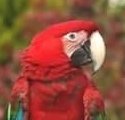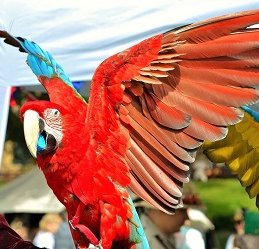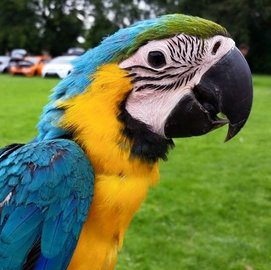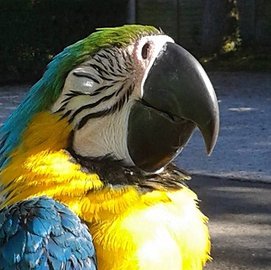

Green-Winged Macaw
Species Profile
Common Names: Red and Green Winged Macaw
Scientific Name: Ara chloropterus
Native Region: Northern South America, Central America, Paraguay, eastern Panama and Mexico.
Average Lifespan: 60 to 65 years
Size: Large, up to 37.5 inches
Weight: 1.2-1.4kilos.
Noise Level: Extremely vocal, Loud and Rowdy
Talk / Trick Ability: Very clever
Temperament: Loving, intelligent very naughty
Diet: Pellets, fresh fruits, vegetables, whole grains and the occasional nut
Egg Clutch: 2-3 white eggs
Incubation: 27 days
Traits:
More outgoing than some of the other macaws, a green-winged macaw can make an affectionate pet. They are also considered more intelligent of the species. Green-winged macaws are often confused with the scarlet macaw because of their similar colouring, but as their name describes they have more green on their wings. Green-winged macaws adapt quickly to a new environment and will quickly become a loving member of the family.
Behaviour / Health Concerns:
Green-winged macaws require a higher fat content in their diet than parrots, so provide a healthy diet consisting of pellets, fresh fruits, vegetables, whole grains and nuts. Nuts are not a luxury in a Green-wing’s diet: they are an essential. Walnuts, almonds and Brazil nuts, pecans and macadamias are excellent.
They are prolific chewers and can have overgrown beaks, so provide plenty of hard wood blocks and other hard toys to give their beaks a good work out. They are susceptible to papillomas, proventricular dilatation disease (PDD, also known as “macaw wasting” disease), polyomavirus, psittacosis and vitamin-A sensitivity. Green-winged macaws do not usually reach full size until about 1-and-a-half years of age. As babies, most macaws have dark eyes that lighten with age. Because green-winged macaws are sociable and live in large flocks in the wild, they need plenty of daily interaction with fellow flock members. These pet birds enjoy being part of the daily household routines.


Blue and Gold Macaw
Species Profile
Common Names: Blue and Gold Macaw, Blue and Yellow Macaw
Scientific Name: Ara ararauna
Origin: South America (Venezuela, Peru, Brazil, Bolivia
Average Lifespan: 40 years average, up to 60 years
Size: 33 to 36 inches
Weight: 900-1500 grams, and Paraguay)
Noise Level: Extremely vocal and Loud
Talk / Trick Ability: Very Good
Temperament: Loving, intelligent very naughty
Diet: Pellets, fresh fruits, vegetables, whole grains and nuts
Egg Clutch: 2-3 white eggs
Incubation: days: 28 days
Traits:
The well-known blue-and-gold macaw enjoys plenty of attention, head scratching and cuddling, but also likes to play and chew, so provide it with colourful hard wooden blocks to destroy. They need lots of room to stretch their wings, so the largest cage possible is ideal. Blue-and-gold macaws are sociable, easy-going birds that are affectionate and tolerant creatures.
Behaviour / Health Concerns:
As with all macaws, blue-and-gold macaws are big and will sometimes play rough and enjoy screaming, but love attention and training can reduce biting and other problem behaviour. If their nipping is not properly dealt with the bad biting habit can develop into a potential problem. With enough interactive time with those in the household, this macaw's nippiness and moods can be solved. As a baby, the blue-and-gold macaw are larger than most parrots, and need patience and understanding during their development. Blue-and-gold macaws require more fat in their diet than other parrots, which you can provide with pellet-based diet, fresh fruits, vegetables, whole grains and nut such as brazil nuts, walnuts, pecans, Brazil nuts and macadamia is also important. They are prolific chewers, so offer toys to chew and destroy often. They are susceptible to overgrown beaks, papillomas, proventricular dilatation disease (PDD, also known as “macaw wasting” disease), psittacosis and vitamin-A sensitivity.
Considering buying a macaw please read this article
Parrot are divided into two categories: Old World and New World species.
New world parrots are found in Central and South America and Mexico. These are the macaws, amazons and conures.
Old World parrots are found in Asia, Africa and Australia. These are the cockatoo, senegal, cockatiel and Indian ringnecks.
Over recent years, veterinarians started to discover that serious, life threatening diseases were developing in macaws who shared living quarters with a dusty, Old World bird. Macaws are very sensitive to airborn particulates and more easily develop respiratory issues and pulmonary disease with continued exposure to powder down dust. Of the macaws, the blue and gold macaw has shown itself to be most at risk.
This post is not to dictate how to look after your birds just guidance that could stop suffering to Blue and Gold Macaws.
Please check the website out below for informative information.
https://birdtricksstore.com/blogs/birdtricks-blog/why-you-should-keep-certain-parrot-species-separated
